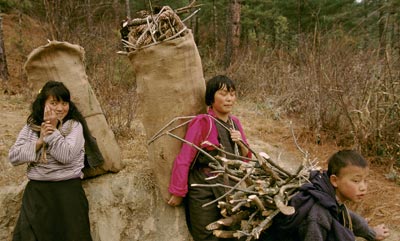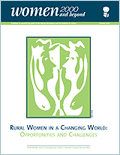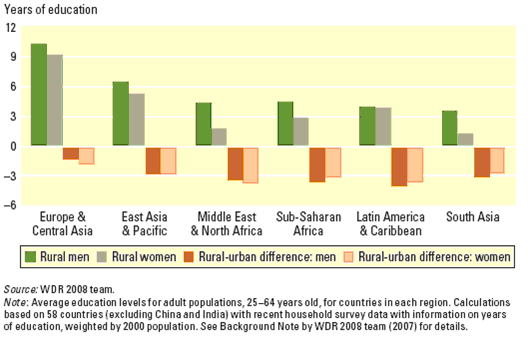

 International Day of Rural Women
International Day of Rural Women
15 October 2008 |
 |
International Day of Rural Women 2008

|
The first International Day of Rural Women was observed on 15 October 2008. This new international day, established by the General Assembly in its resolution 62/136 of 18 December 2007, recognizes “the critical role and contribution of rural women, including indigenous women, in enhancing agricultural and rural development, improving food security and eradicating rural poverty.”
The idea of honouring rural women with a special day was put forward by international NGOs at the Fourth World Conference on Women in Beijing in 1995. It was suggested that 15 October be celebrated as “World Rural Women’s Day,” the eve of World Food Day, in order to highlight the role played by rural women in food production and food security. “World Rural Women’s Day” has been celebrated, primarily by civil society, across the world for over a decade.
In 2007, at the tenth session of the Regional Conference on Women in Latin America and the Caribbean, Member States of the Economic Commission for Latin America and the Caribbean, expressed in the Quito Consensus their decision to promote the adoption of an International Day of Rural Women “as an explicit recognition of [rural women’s] economic contribution and the development of their communities, in particular with regard to the unpaid work they perform.”1
|
The contribution of rural women
The International Day of Rural Women directs attention to both the contribution that women make in rural areas, and the many challenges that they face. Women play a critical role in the rural economies of both developed and developing countries. In most parts of the developing world they participate in crop production and livestock care, provide food, water and fuel for their families, and engage in off-farm activities to diversify the family income. In addition, they carry out vital functions in caring for children, older persons and the sick.
Women make an important contribution to food production. According to the International Labour Organization (ILO), 428 million women work in the agricultural sector around the world, compared to 608 million men. In many parts of the world, agriculture is the first sector of employment for women, for instance in Sub-Saharan Africa and in South Asia, where respectively 68 per cent and 61 per cent of working women are employed in agriculture.2
|
Access to education and health
In developing countries, 25 per cent of rural children do not attend primary school, compared to 16 per cent of urban children,3 and gender inequalities in access to education remain: 69 per cent of rural girls attend primary school compared to 73 per cent of rural boys.4
Different factors, including the need for their labour, the low levels of education of their parents, and lack of access to quality schooling, account for the high proportion of out-of-school children in rural areas.5 The gender disparity is partly due to the fact that girls are heavily relied upon for housework and child care. Other factors that account for girls’ unequal access to education in rural areas include a lack of a safe means of transportation, poor security in schools, and the lack of separate sanitation facilities.
Rural women are also disadvantaged in their access to health. For instance, in many countries, reproductive health care remains inadequate, and maternal mortality continues to be high, with the highest rates in Sub-Saharan Africa. In every region of the world, the presence of skilled birth attendants is lower in rural than in urban areas.
Fistula: a rural issue
“One of the most serious injuries of childbearing is obstetric fistula, a hole in the vagina or rectum caused by labour that is prolonged – often for days – without treatment. Usually the baby dies. Because the fistula leaves women leaking urine or faeces, or both, it typically results in social isolation, depression and deepening poverty. Left untreated, fistula can lead to chronic medical problems.
Like maternal mortality, fistula is almost entirely preventable. Yet at least 2 million women in sub-Saharan Africa, South Asia and the Arab region are living with fistula, and some 50,000 to 100,000 new cases develop each year. (…) Obstetric fistula occurs disproportionately among impoverished girls and women, especially those living far from medical services.”
Source: UNFPA website |
Most pregnant women in rural areas continue to work while pregnant and resume work soon after delivery. Moreover, the absence of timely medical care, inadequate diet and heavy workload often results in complicated pregnancies and high maternal mortality rates.6
|
Poverty
Rural women are particularly vulnerable to poverty. According to the World Bank, 75 per cent of the poor in developing countries live in rural areas.7 While women work the land, they often do not hold formal and clear land titles. Less than two per cent of land in the developing world is owned by women, according to the International Fund for Agricultural Development (IFAD).8 A lack of rights over land makes women extremely vulnerable to eviction and negatively affects their economic options.
Women’s access to credit is also limited because land is the major asset used as collateral to obtain loans. Women have to rely heavily on the unregulated, informal sector to meet their needs, and often pay higher interest rates as a result. While limited access to land and credit affects rural women as a whole, some groups are particularly vulnerable and marginalized, such as widows, indigenous women and women heading households – a growing category, due to male out-migration.
|
Global challenges
Women and girls, particularly in rural areas, are also acutely exposed to the food crisis currently affecting the world. High food prices mean that the poor have to spend a larger proportion of their income on food and will probably buy less food or food that is less nutritious.


The time burden of collecting wood for fuel
“Women and young girls have to allocate large amounts of time to the collection of firewood, compounding gender inequalities in livelihood opportunities and education. Collecting fuelwood and animal dung is a time-consuming and exhausting task, with average loads often in excess of 20kg. Research in rural Tanzania has found that women in some areas walk 5–10 kilometres a day collecting and carrying firewood, with loads averaging 20kg to 38kg. In rural India, average collection times can amount to over 3 hours a day. Beyond the immediate burden on time and body, fuelwood collection often results in young girls being kept out of school.”
Source: UNDP Human Development Report 2007/2008 |
Moreover, in some societies the practice for men and boys to eat before women and girls may further compromise the latter’s food intake in times of shortages.
Another current global issue that disproportionately impacts rural women is climate change. Women and girls living in areas affected by desertification and deforestation have to walk longer to collect water and firewood, which further limits the time they can devote to school or income-generating activities. It may also put them at greater risk of gender-based violence.
Moreover, rural women suffer more from natural disasters, such as floods, fires, and mudslides, than men. A study of 141 countries showed that natural disasters killed more women than men, both directly and indirectly, in countries where the status of women was low.9 Other research provides evidence that there are frequently higher female casualties during floods because women have not been taught how to swim.10
|
International framework
Ensuring gender equality is a key concern of the United Nations, and over the past decades, a number of United Nations conferences and summits have addressed the situation of rural women. These include the Fourth World Conference on Women, in 1995, and the Millennium Summit, in 2000.
Moreover, the Convention on the Elimination of All Forms of Discrimination against Women is the only human rights instrument that specifically addresses the situation of rural women. Article 14 calls on States parties to eliminate discrimination against rural women and to ensure that all provisions of the Convention are applied to rural women.
Despite this attention given to the situation of rural women, discrimination remains rampant, from access to education and health care, to access to and control over land and other productive resources, to opportunities for employment, income-generating activities, and participation in public life. The rights and priorities of rural women continue to be insufficiently addressed – a situation that the International Day of Rural Women will, it is hoped, contribute to remedying.
|
|
|




